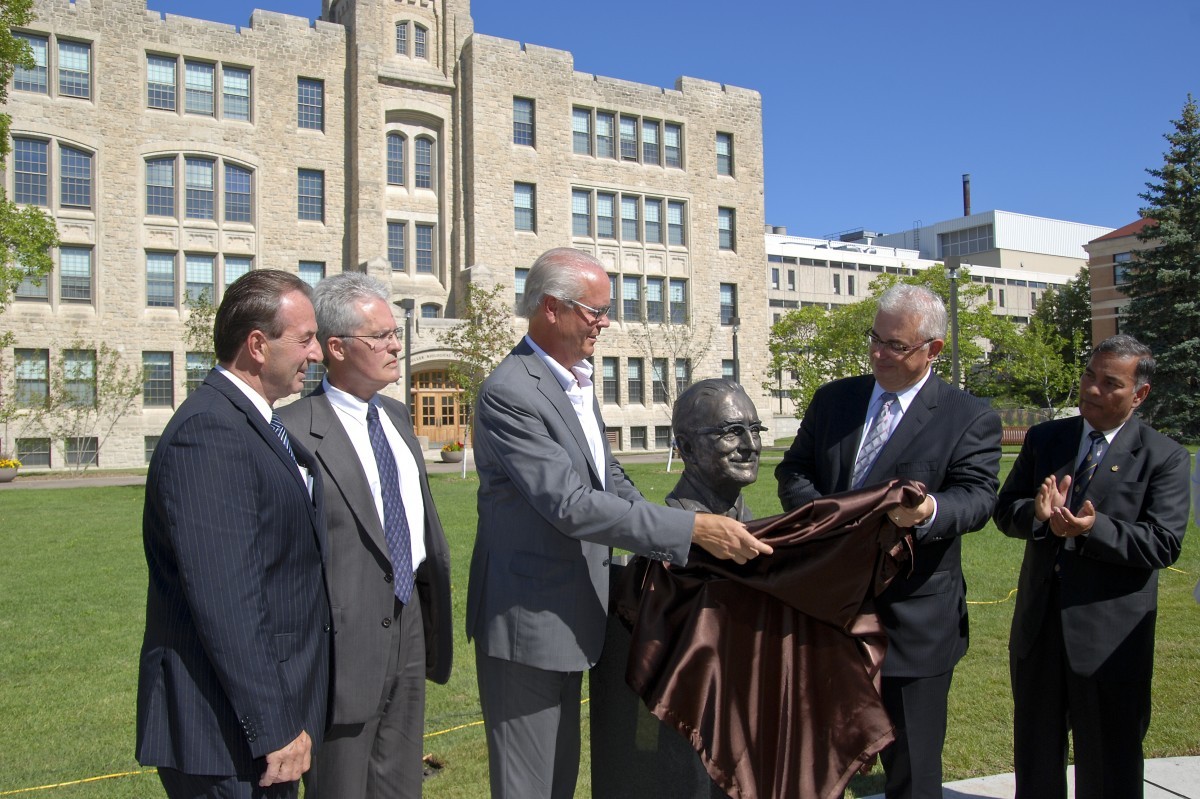
Innovation Plaza opens, celebrates Father of Canola
A new public space in a park-like setting has been dedicated at the University of Manitoba to inspire visitors and celebrate the achievements of noted University of Manitoba scholars and researchers.
Innovation Plaza honours the most distinguished researchers, scholars and creators at the University of Manitoba. Located on the south lawn of the Buller Building at Auld Place on the Fort Garry Campus, Innovation Plaza features at its heart a series of commemorative busts that acknowledge and celebrate individuals who have greatly enriched society and contributed significantly to the social, cultural or economic well-being of Canada and the world.
“Innovation Plaza provides us the opportunity to further celebrate world-class researchers whose ideas and hard work at the University of Manitoba have transformed our lives,” President and Vice-Chancellor Dr. David Barnard said at the Aug. 22 opening ceremony . “I want to thank the Richardson Foundation for its generosity and leadership in support of this plaza. It will serve as an inspiration to students and is a visible reminder of the global benefit that results from discovery on our campuses.”
The plaza’s inaugural inductee is Dr. Baldur Stefansson, the father of canola. His installation was sponsored by the Richardson Foundation, and the sculpture was created by artist Madeleine Vrignon (BFA/1979).
“The University of Manitoba is home to many researchers whose breakthroughs are changing our world for the better,” says Hartley T. Richardson, President & Chief Executive Officer of James Richardson & Sons, Limited and a Trustee of the Richardson Foundation. “Innovation Plaza will be an incredible testament to the men and women who have been pioneers in their respective vocation – visionaries aspiring to take the path less chosen and in turn inspiring others. Dr. Stefansson’s work in the development of canola has had a tremendous influence on Canadian agribusiness, opening new markets for this versatile oilseed and providing more options for agricultural producers and processors.”
Dr. Baldur R. Stefansson OC, OM, (1917-2002) (BSA/50, MSc/52, PhD/66, LLD/97), is often described as the father of canola. He began his career as an oilseed breeder in the Department of Plant Science and recognized the potential of oilseed rape as an edible oilseed crop for temperate climates. However, oilseed rape has a high erucic acid content and was only useful as an industrial oil. In 1961, through research with collaborators, he created a rapeseed with minimal erucic acid. In 1974, Stefansson released Tower, the first ‘double zero’ rape cultivar with less than 5 percent erucic acid and low levels of glucosinolates, which cause bitterness in vegetables such as cauliflower and Brussels sprouts. The significant improvements in both oil and meal quality, as well as taste, were recognized in a new commodity name canola. In 1987, Stefansson registered the world’s first low linolenic canola cultivar, Stellar, and products made with canola have since been commonplace on grocery shelves.
Stefansson became an internationally recognized plant breeder and was inducted to the Canadian Agricultural Hall of Fame. He was made an officer of the Order of Canada and received the Order of Manitoba. In 1997, he received an honorary doctorate from the University of Manitoba.
“Canola is one of Canada’s greatest contributions to agriculture worldwide, and I am very proud to say that it was developed right here at the University of Manitoba, by our first inductee into Innovation Plaza, Dr. Baldur Stefansson, who is truly the ‘father of canola,’ said Dr. Digvir Jayas, Vice-President (Research and International). “Innovation Plaza has been created to honour the most distinguished individuals at the University of Manitoba.”
As more individuals are honoured in coming years, the plaza will be lined with busts of innovators. Visitors such as students walking through the plaza and guests on campus will be inspired by the lives and stories of University of Manitoba researchers.
Research at the University of Manitoba is partially supported by funding from the Government of Canada Research Support Fund.







I had the privilege of sitting in Dr. Stefansson’s plant science classes. He was a man with a big brain and a common touch. I am proud to have met him, however briefly.
… Bob Funk, B.S.A (1970)
You did not mentioned the roles that Drs. Vivian Bruce and Marian Vaisey Gensler played in the development of canola for human use. Where do they fit in this story? Thank you.